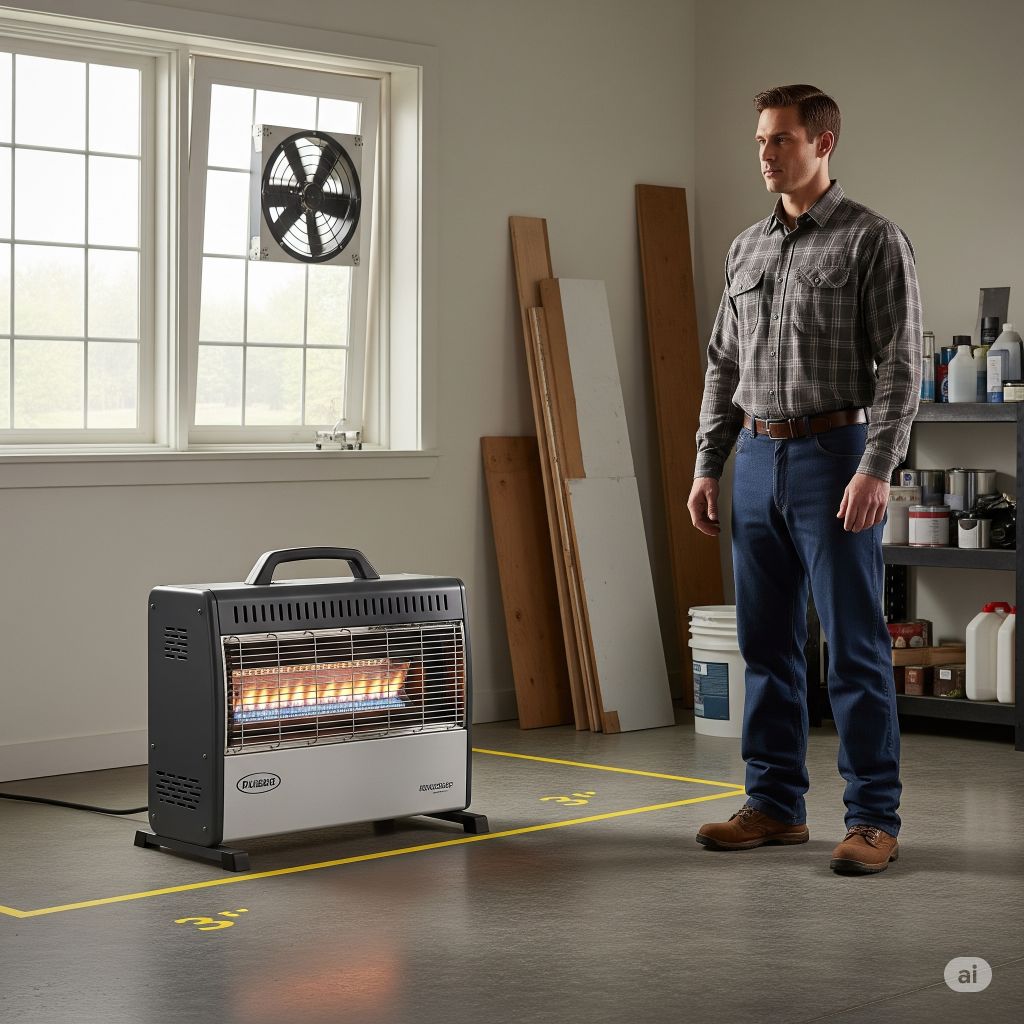
As a seasoned blogger, I’ve delved into the topic of using propane heaters indoors. It’s a common question that arises, especially during the colder months. Safety is paramount when it comes to heating your indoor spaces. Propane heaters can be a convenient and efficient way to warm up your home, but there are crucial factors to consider before bringing one inside. In this article, I’ll provide you with valuable insights and guidelines on whether it’s safe to use a propane heater indoors. Let’s explore the dos and don’t to keep your home cozy and secure.
Key Takeaways
- Understand that propane heaters are primarily designed for outdoor use due to the risks they pose indoors, especially in relation to carbon monoxide (CO) gas production.
- Risks of using propane heaters indoors include CO poisoning, fire hazards, and the importance of proper ventilation to prevent dangerous CO buildup.
- Adhere to safety guidelines when using propane heaters indoors, including maintaining proper ventilation, installing CO detectors, keeping a safe distance from flammable materials, regular maintenance, and never leaving the heater unattended.
- Consider alternative heating options such as electric space heaters, wood-burning stoves or fireplaces, radiant floor heating, heat pumps, and electric blankets or heated mattress pads to prioritize safety and find the most suitable heating solution for indoor spaces.
Understanding Propane Heaters
When it comes to propane heaters, it’s crucial to comprehend their features and how they operate indoors. These heaters are designed for outdoor use primarily, due to the potential risks they pose when used indoors.
Propane heaters work by burning propane gas to generate heat. They produce carbon monoxide (CO), a colorless and odorless gas that can be lethal in high concentrations. Ventilation is key when using propane heaters indoors to prevent CO buildup.
Portable propane heaters are convenient for their mobility, but they require careful monitoring and must never be left unattended. Size matters too, as heating a large space with an insufficiently sized heater can be inefficient and even dangerous.
Remember, safety always comes first when using propane heaters indoors.
Risks of Using Propane Heaters Indoors
Using propane heaters indoors can pose several risks that are crucial to be aware of for safety reasons. Propane heaters produce carbon monoxide (CO) gas when in operation, which can be extremely dangerous when used in enclosed spaces. CO is colorless and odorless, making it difficult to detect without a carbon monoxide detector. Exposure to high levels of CO can lead to symptoms like headaches, dizziness, nausea, and even death.
Improper ventilation is a significant risk factor when using propane heaters indoors. Without adequate airflow, CO can build up quickly to dangerous levels, putting occupants at risk of CO poisoning. It’s essential to ensure that there is proper ventilation in the room where the propane heater is being used to allow for the safe dispersion of CO gas.
Another risk is the potential for fire hazards when using propane heaters indoors. Propane heaters generate heat and can pose a fire risk if they come into contact with flammable materials or are placed too close to furniture, curtains, or other combustible items. It’s crucial to keep flammable objects at a safe distance from the heater to prevent accidents.
In summary, understanding and addressing the risks associated with using propane heaters indoors are essential for the safety of occupants. Taking appropriate precautions, such as ensuring proper ventilation, using a carbon monoxide detector, and maintaining a safe distance from combustible materials, can help mitigate these risks and prevent potential accidents or health hazards.
Safety Guidelines for Indoor Propane Heater Use
Safety is paramount when using propane heaters indoors. Carbon monoxide (CO) gas can pose a serious threat, given its colorless and odorless nature. To ensure safe usage, follow these essential guidelines:
- Ventilation is Key:
Ensure proper ventilation by opening windows or doors when using a propane heater indoors. This allows the harmful CO gas to dissipate, reducing the risk of exposure. - Carbon Monoxide Detectors are a Must:
Install CO detectors in your home, especially near sleeping areas. These detectors can alert you to dangerous levels of CO, providing an early warning sign of potential danger. - Keep a Safe Distance:
Maintain a safe distance between the propane heater and any flammable materials. This reduces the risk of fire hazards and ensures a safe environment. - Regular Maintenance:
Regularly inspect and maintain your propane heater according to the manufacturer’s instructions. This helps ensure proper functioning and reduces the likelihood of malfunctions or gas leaks. - Avoid Unattended Use:
Never leave a propane heater unattended. Turn it off when not in use to prevent accidents or gas leaks in your absence.
By adhering to these safety guidelines, you can enjoy the warmth of a propane heater indoors while minimizing the associated risks. Stay vigilant and prioritize safety at all times.
Alternative Heating Options
When it comes to indoor heating, safety should always be the top priority. While indoor propane heaters can be a convenient option, it is essential to consider Alternative Heating Options that are both effective and safe for indoor use. Here are some alternatives to consider:
- Electric Space Heaters: These heaters are portable, easy to use, and do not emit harmful gases like carbon monoxide. They come in various sizes and styles, making them suitable for different room sizes and aesthetics.
- Wood-Burning Stoves or Fireplaces: For those looking for a cozy ambiance, wood-burning stoves or fireplaces can be a great option. However, it is crucial to ensure proper ventilation and chimney maintenance to prevent the buildup of harmful gases.
- Radiant Floor Heating: This energy-efficient heating system provides warmth from the floor up, creating a comfortable environment without the need for visible heating units. It can be a great long-term heating solution for homes.
- Heat Pumps: Heat pumps are ideal for maintaining a consistent indoor temperature while minimizing energy consumption. They work by transferring heat between the indoors and outdoors, making them an eco-friendly choice for heating.
- Electric Blankets or Heated Mattress Pads: For more localized heating, electric blankets or heated mattress pads can provide warmth without heating the entire room. They are great for use in bedrooms during cold nights.
Exploring Alternative Heating Options can not only ensure your safety but also help you find the most suitable heating solution for your indoor space. By being aware of the various options available, you can make an informed decision that meets your heating needs while prioritizing indoor safety.
Conclusion
Ensuring safety is paramount when using indoor propane heaters due to the potential risks associated with carbon monoxide (CO) gas. Exploring alternative heating options such as Electric Space Heaters, Wood-Burning Stoves or Fireplaces, Radiant Floor Heating, Heat Pumps, and Electric Blankets or Heated Mattress Pads can provide effective and safe solutions for indoor heating needs. Each option comes with unique benefits and considerations to enhance indoor comfort while prioritizing safety. By making informed decisions and considering these alternatives, individuals can create a warm and secure indoor environment.
Frequently Asked Questions
Are indoor propane heaters safe to use?
Yes, indoor propane heaters can be safe if used correctly. It’s essential to ensure proper ventilation to prevent carbon monoxide buildup and follow manufacturer’s guidelines.
What are the risks associated with carbon monoxide (CO) gas from propane heaters?
Carbon monoxide (CO) gas is a colorless, odorless gas produced by incomplete combustion. It can lead to carbon monoxide poisoning, causing symptoms like dizziness, headache, nausea, and even death.
What are some alternative heating options for indoor spaces?
Alternative heating options for indoor spaces include Electric Space Heaters, Wood-Burning Stoves or Fireplaces, Radiant Floor Heating, Heat Pumps, and Electric Blankets or Heated Mattress Pads.
How do I ensure indoor safety when using alternative heating options?
To ensure indoor safety when using alternative heating options, follow proper installation guidelines, perform regular maintenance, and use devices according to manufacturer’s instructions.
How can individuals make informed decisions about indoor heating options?
Individuals can make informed decisions by researching different heating options, considering their specific needs, consulting professionals if necessary, and prioritizing safety and efficiency.
